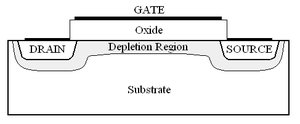CMOS: Difference between revisions
From ETHW
No edit summary |
No edit summary |
||
| (One intermediate revision by one other user not shown) | |||
| Line 1: | Line 1: | ||
<p>'''''This article is a stub. You can help the GHN by expanding it.''''' </p> | <p>'''''This article is a stub. You can help the GHN by expanding it.''''' </p> | ||
<p>At a meeting in October 1968 the Westinghouse Molecular Electronics division announced a new type of field-effect transistor, the CMOS (Complementary Metal-Oxide-Semiconductor). Its much lower power usage makes portable devices more viable, and | <p>At a meeting in October 1968 the Westinghouse Molecular Electronics division announced a new type of field-effect transistor, the CMOS (Complementary Metal-Oxide-Semiconductor). Its much lower power usage makes portable devices more viable, and enables efficient, low power, memory storage. </p> | ||
<p>[[Image:Cmos.PNG|thumb|center|Side view of a CMOS transistor]]</p> | <p>[[Image:Cmos.PNG|thumb|center|Side view of a CMOS transistor]]</p> | ||
[[Category:Components,_circuits,_devices_&_systems]] | |||
[[Category:Integrated_circuits]] | |||
[[Category:CMOS_integrated_circuits_&_microprocessors]] | |||
Revision as of 19:55, 26 July 2012
This article is a stub. You can help the GHN by expanding it.
At a meeting in October 1968 the Westinghouse Molecular Electronics division announced a new type of field-effect transistor, the CMOS (Complementary Metal-Oxide-Semiconductor). Its much lower power usage makes portable devices more viable, and enables efficient, low power, memory storage.
